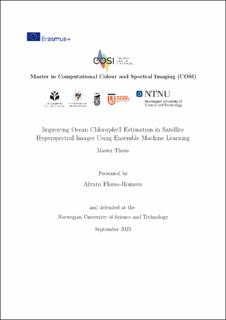| dc.description.abstract | Chlorophyll can be used as a convenient way to study and monitor water quality in coastal regions. Traditional techniques to measure chlorophyll, such as fluorescence analysis, are expensive and time-consuming, as they require in situ long lasting campaigns. The use of high-frequency spectral images taken from space-borne imagers, such as the one in the HYPSO-1 mission, has become a more feasible alternative around the world. Although it is challenging, it is possible to retrieve surface reflectance from a hyperspectral imager after removing the atmospheric effects by aerosols and molecules.
This work addresses the problem of chlorophyll estimation with the surface reflectance of HYPSO-1 spectral images. First, a radiative transfer model of the 6SV1 algorithm was implemented for the first time on this small satellite so that the reflectance could be obtained from a spectral image. Second, pixels were classified to uniquely study those corresponding to ocean regions. Third, reflectance features that were highly correlated with measured chlorophyll concentrations were selected to improve the estimation process. Finally, fine-tuned features were combined with linear and polynomial regression, as well as ensemble machine learning techniques to identify the best performance of different approaches.
After atmospheric correction, it was possible to classify water pixels based on reflectance with a 98.3% accuracy, which is a useful method to overcome the problem of inconsistent telemetry data. Selecting the most appropriate features enhanced the performance of the model. The proposed "voting" ensemble machine learning approach performed better than traditional empirical methods, which was validated by using BOA reflectance measurements from the GLORIA dataset. Therefore, we can conclude that the concentration of ocean chlorophyll can be reliably estimated using hyperspectral images from the HYPSO-1 satellite. | |
